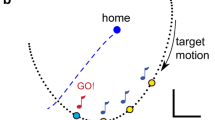Abstract
We investigated the capacities of human subjects to intercept moving targets in a two-dimensional (2D) space. Subjects were instructed to intercept moving targets on a computer screen using a cursor controlled by an articulated 2D manipulandum. A target was presented in 1 of 18 combinations of three acceleration types (constant acceleration, constant deceleration, and constant velocity) and six target motion times, from 0.5 to 2.0 s. First, subjects held the cursor in a start zone located at the bottom of the screen along the vertical meridian. After a pseudorandom hold period, the target appeared in the lower left or right corner of the screen and traveled at 45º toward an interception zone located on the vertical meridian 12.5 cm above the start zone. For a trial to be considered successful, the subject’s cursor had to enter the interception zone within 100 ms of the target’s arrival at the center of the interception zone and stay inside a slightly larger hold zone. Trials in which the cursor arrived more than 100 ms before the target were classified as ”early errors,” whereas trials in which the cursor arrived more than 100 ms after the target were classified as ”late errors.” Given the criteria above, the task proved to be difficult for the subjects. Only 41.3% (1080 out of 2614) of the movements were successful, whereas the remaining 58.7% were temporal (i.e., early or late) errors. A large majority of the early errors occurred in trials with decelerating targets, and their percentage tended to increase with longer target motion times. In contrast, late errors occurred in relation to all three target acceleration types, and their percentage tended to decrease with longer target motion times. Three models of movement initiation were investigated. First, the threshold-distance model, originally proposed for optokinetic eye movements to constant-velocity visual stimuli, maintains that response time is composed of two parts, a constant processing time and the time required for the stimulus to travel a threshold distance. This model only partially fit our data. Second, the threshold-τ model, originally proposed as a strategy for movement initiation, assumes that the subject uses the first-order estimate of time-to-contact (τ) to determine when to initiate the interception movement. Similar to the threshold distance model, the threshold-τ model only partially fit the data. Finally, a dual-strategy model was developed which allowed for the adoption of either of the two strategies for movement initiation; namely, a strategy based on the threshold-distance model (”reactive” strategy) and another based on the threshold-τ model (”predictive” strategy). This model provided a good fit to the data. In fact, individual subjects preferred to use one or the other strategy. This preference was allowed to be manifested at long target motion times, whereas shorter target motion times (i.e., 0.5 s and 0.8 s) forced the subjects to use only the reactive strategy.
Similar content being viewed by others
Author information
Authors and Affiliations
Additional information
Received: 5 July 1996 / Accepted: 4 March 1997
Rights and permissions
About this article
Cite this article
Port, N., Lee, D., Dassonville, P. et al. Manual interception of moving targets I. Performance and movement initiation. Exp Brain Res 116, 406–420 (1997). https://doi.org/10.1007/PL00005769
Issue Date:
DOI: https://doi.org/10.1007/PL00005769



